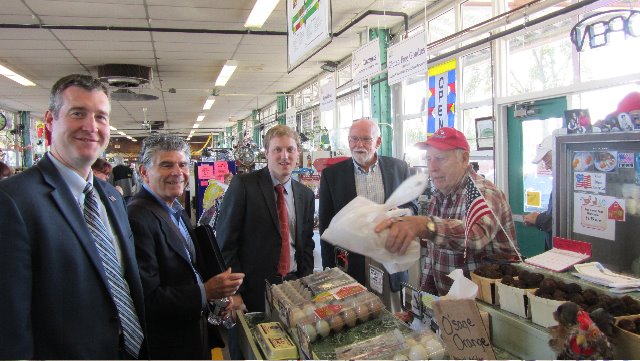DUFB takes off in electronic form
Author: Rachel Chadderdon, DUFB Program Manager
Shorter days and hard frosts herald the end of the farmers’ market season in Michigan – most markets, except those determined to stay open all winter, close for the season by the end of October. Double Up Food Bucks also ended at most markets on October 30, bringing to a close a record-breaking season. Customers using Bridge Cards shopped at DUFB-participating markets nearly 40,000 times, using over $650,000 in federal food stamp benefits and over $550,000 in DUFB matching tokens to purchase Michigan-grown produce!
But DUFB remains in action for one more month, until the end of November, at the Flint Farmers Market. A year-round public market, the Flint Farmers Market is second only to Detroit Eastern Market in annual Bridge Card sales and has long been a critical access point for low-income families looking to connect with local farmers. We’re thrilled to have the Flint Farmers Market as a DUFB partner – and equally excited about the groundbreaking electronic DUFB system now in place there.
At all other markets in Michigan, the market management operates a central terminal to accept Bridge Cards and issues tokens for customers to spend with vendors in the market, giving out the DUFB matching tokens at the same time. But at the Flint Farmers Market, each vendor who wants to accept SNAP benefits has his or her own point-of-sale device, so customers use their cards directly with each vendor – no tokens involved. Neither customers, vendors, nor the market management wanted to work with tokens. In order to distribute the DUFB match, we had to find a way to do it electronically.
We at FFN looked far and wide to find a software company that could help with this challenge, and found the solution in the Flint Farmers Market’s own backyard: Epic Technology Solutions (ETS), a Flint-based web hosting and software development startup owned by brothers Paul and Eric Knific, jumped at the opportunity to help their local farmers’ market while growing their local business. Paul and his team have developed a DUFB Card System that lets customers receive and spend DUFB “credits” on a reward card.
Here’s how it works: First, the customer goes to a sign-up booth in the market with her Bridge Card and a state-issued ID card, and a market employee activates a DUFB Market Card for her. Then, she goes into the market and shops with participating vendors (there are currently 16 participating out of a total of 30-40). When she makes a purchase, the vendor debits the Bridge card then swipes her Market Card and adds an equal amount of DUFB credits to the Market Card (i.e., a $5 Bridge Card purchase “earns” her $5 in DUFB credits on her Market Card). Then, she can take her Market Card to any participating vendor to spend those credits on Michigan-grown fruits and vegetables.

(L to R): Flint Mayor Dayne Walling, Oran Hesterman, Paul Knific, Epic Technology Solutions, Flint Farmers Market Manager Dick Ramsdell, Hough Godfrey, of H. Godfrey’s Poultry and Eggs
The electronic system has some distinct advantages over the token system: it’s secure, because each Market Card is linked to a customer’s state ID. The software automatically caps each customer’s DUFB match at $20/day. All DUFB transaction information is stored on a secure server at the market, making it easy for management to monitor the program and reimburse vendors with less paperwork. And the customer experience is simpler, too – just one card to carry, instead of a handful of tokens.
If electronic benefits transfers and electronically-administered incentive programs are the wave of the future (and we think they are), then the Flint Farmers Market is leading the way.
FFN offers a huge thank you to Dick Ramsdell, Karianne Martus, and all the staff at the Flint Farmers Market, and to Paul Knific and his team at Epic Technology Solutions. Funding for the Flint DUFB Card System comes from the C.S. Mott Foundation, Ruth Mott Foundation, and Open Society Foundations.








